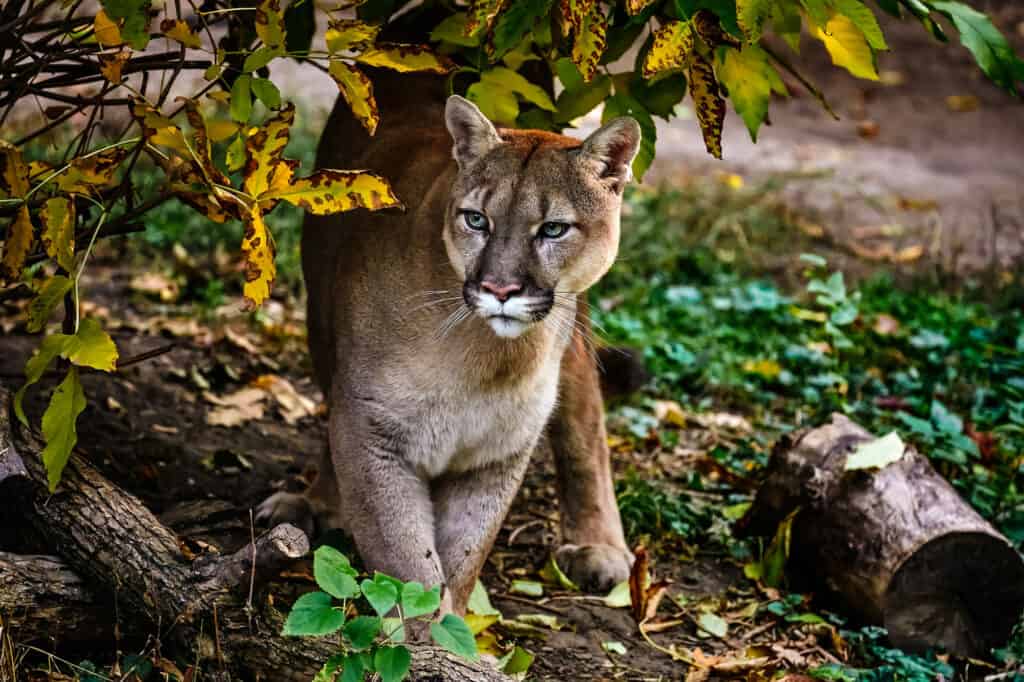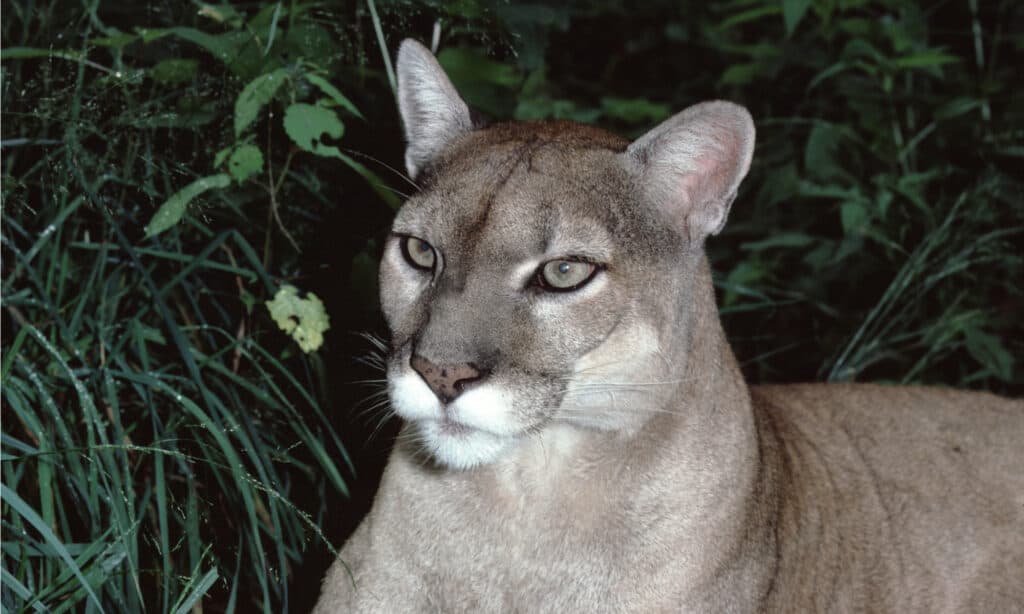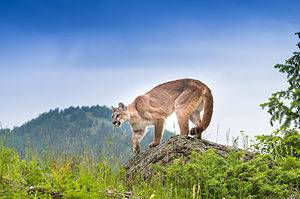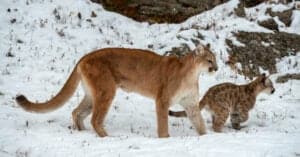Quick Answer:
- No, there are no mountain lions in North Carolina according to the North Carolina Wildlife Resources Commission (NCWRC).
- Mountain lions were driven from North Carolina in the late 1800s due to settler expansion, which caused habitat destruction, as well as hunting practices.
Stories about mountain lions go viral these days, thanks to easy internet access. Eerie nighttime photos from trail cameras and tales of mountain lions attacking hikers flood social media and news channels. They are so prevalent that many people believe there are more mountain lions than there really are. The majestic cat only lives in a small portion of the United States. But if so, are there mountain lions in North Carolina?
We explore that question, along with a glimpse into mountain lion sightings, in the article below. However, to help set the stage and offer some perspective, we first look at basic details about the large cat.
What Are Mountain Lions?
Mountain lions (Puma concolor) are one of the largest cats in the Americas. They belong to the Felidae (cat) family and have many common names. Depending on where you live, you may know them as pumas, panthers, cougars, or catamounts. The predator is a carnivore and a highly-skilled, elusive hunter. They prefer larger prey like deer and elk. However, it is not uncommon for them to eat smaller animals like coyotes, raccoons, and mice. Additionally, they will gladly target any domesticated pets or livestock left outside unprotected.
Their size is a little hard to wrap your head around. People often picture them much smaller (or larger) than they are. Mountain lions range between 80-225 pounds and 6 to 9 feet long (nose to tail). Adult females are smaller, averaging 80-90 pounds. But adult males average 140 pounds and are 7 feet long from snout to tail.
Their beige or tawny fur helps camouflage them in countless environments. Most of their fur is a shade of beige, although some develop a darker reddish-orange color. Mountain lions’ underbellies are white or gray. And they have some black accents. Typically these occur on the end of the tail, edges of the ears, and around the snout and eyes.
The solitary animals have very large home territories. Males travel up to 100 square miles, while females stick closer to 60 square miles. They rarely come together outside of mating season. However, adult females keep their kittens with them until the young ones can strike out on their own.

Mountain lions are solitary creatures and roam large territories.
©MelaniWright/Shutterstock.com
Where Do Mountain Lions Live Around the World?
Mountain lions live in incredibly diverse environments, but all call the Western Hemisphere home. Historically, their range ran from the southern tip of Chile up to the northern edges of the Yukon. However, hunting practices and habitat loss drastically reduced the overall population over the last few centuries.
Now, mountain lions still live in most of South and Central America, though there are far fewer of them. They also live in much of Canada. But the large cat is officially considered endangered up north.
In the United States, the population diminished rapidly during the mid to late 1800s and into the early 1900s. Today a small population, estimated at around 200, of Florida panthers still reside in the state. However, only 15 other states have residential mountain lion populations. No other states have a confirmed breeding population.
Mountain lions are not terribly picky about their environment. They happily roam in mountains, wetlands, deserts, and forests. And they make their way up to 10,000 feet in elevation and along sea level. There are two primary factors that mountain lions need.
First is plenty of prey. As long as there is enough food for the large felines, they will gladly stay in an area. But they also need places to hide as they stalk their prey. Mountain lions prefer rocky, cliff-filled areas or plenty of trees and bushes to hide behind.

Mountain lions live in wetlands, forests, deserts, and mountains.
©Evgeniyqw/Shutterstock.com
Where Do Mountain Lions Live in North Carolina?
The impressive animals were so common in North Carolina that many places and natural features got named after them. Eastern cougars (Puma concolor cougar) are a subspecies of mountain lion and were the cats that roamed the state. However, some speculate that the Florida panther also made its way into North Carolina.
But according to the North Carolina Wildlife Resources Commission (NCWRC), there is no longer a residential population of mountain lions in the state. After settler expansion that resulted in habitat destruction, and hunting practices, the elusive animals were extirpated in the late 1800s. And no sightings were reported for nearly a century.
Officials investigate reports of mountain lion sightings fairly regularly. However, biologists have not found any physical evidence that the cats still call North Carolina home.

Mountain lions were extirpated from North Carolina in the late 1800s.
©iStock.com/SandmanXX
Mountain Lion Sightings in North Carolina
The NCWRC receives regular reports of mountain lion sightings in North Carolina. Most are residents claiming to have video evidence or have seen tracks. Biologists from the agency investigate these reports, but most do not pan out. Some of the video evidence presented to the agency does show mountain lions. But it is footage of a mountain lion out west in its natural habitat, not in North Carolina.
Most often, the sightings turn out to be other animals. NCWRC officials find that red foxes with mange, bobcats, coyotes, domestic dogs, and cats are often mistaken for mountain lions.
There is a confirmed report of two mountain lions spotted in Tyrrell County in the 1980s. Those cats were pets that escaped. So other recent sightings may also be due to mountain lions escaping captivity.
However, local residents disagree with the state’s official assessment. There are so many recent sightings that a book about them was published in 1994. Panthers of the Coastal Plains, by Charles R. “Buster” Humphries, discusses 167 mountain lion sightings. However, that number does not reflect the entire state. It was just those occurring within 40 miles of Wilmington. And that was nearly three decades ago. Could the number of sightings have increased over the years?
According to those who claim they saw a mountain lion, yes, the number has increased. And they are adamant that it is not a case of mistaken identity. Most people who say they spotted a mountain lion will tell you the long, distinctive tail of the cat was visible. There is no way what they saw could have been a bobcat, which has a short, blunt tail.
Neighboring states also have an uptick in mountain lion sightings. So many North Carolina residents believe it only makes sense that the large cats are making their way into their state.
Many avid, experienced hunters insist they have crossed paths with a cougar while out on their adventures. An increasing number of North Carolina residents believe the Eastern Cougar has returned. But scientists disagree. It is a debate worth keeping an eye on. Nature does have a way of restoring itself.

The Eastern Cougar was officially declared extinct by federal wildlife officials in 2011.
©Liz Weber/Shutterstock.com
The photo featured at the top of this post is © Warren Metcalf/Shutterstock.com
Sources
- North Carolina Wildlife Resources Commission, Available here: https://www.ncwildlife.org/Learning/Species/Mammals/Eastern-Cougar#:~:text=Cougars%20were%20extirpated%20from%20North,living%20anywhere%20in%20the%20state
- Wrightsville Beach Magazine, Available here: https://wrightsvillebeachmagazine.com/return-of-the-cougar/
FAQs (Frequently Asked Questions)
When did North Carolina lose its mountain lion population?
Scientists believe that the Eastern Cougar was extirpated from North Carolina during the late 1800s, or 1900 at the latest.
What big cats live in North Carolina?
Only one big cat officially calls the state home, and that’s the bobcat.
Should you stare down a mountain lion?
If you encounter a mountain lion, always maintain eye contact. Never turn your back or crouch down. You want to make yourself appear as large and intimidating as possible.
Thank you for reading! Have some feedback for us? Contact the AZ Animals editorial team.






